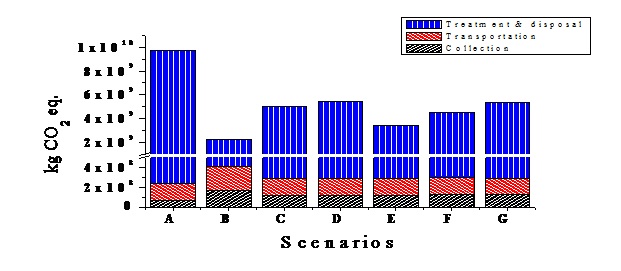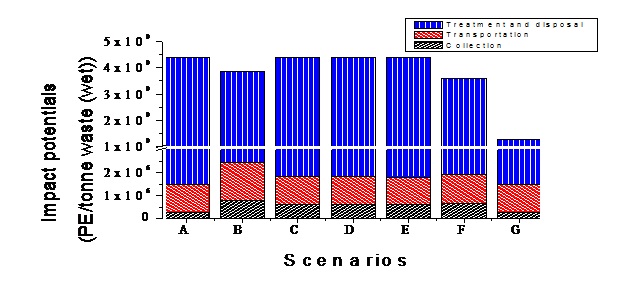Life cycle assessment (LCA)
LCA, initiated since 1990s, is a method for analyzing the environmental intervention and potential impact throughout product life from material acquisition through production, use, and disposal. LCA was developed as a method to account for the environmental impact associated with a product or a service. Nowadays, LCA is one of the most accepted methods applied for evaluating environmental aspects and potential impact starting from cradle (discarded materials from households) to grave (final disposal, substitution of raw materials) through human activities such as the waste management processes (Finnveden, 1999).
EGC applies computer-based model-LCA in order to facilitate evaluation of environmental impact from product and services. In term of waste management, EGC adopts LCA methodology as a standard practice to assess different strategies for integrated solid waste management and to evaluate treatment options for specific waste fractions. In this sense, EGC can provide the outcome of environmental impact to governmental and local sector e.g. global warming potential.
การประเมินวัฐจักร
ตั้งแต่ทศวรรษที่ 90 LCA ได้ก่อกำเนิดขึ้นเพื่อเป็นวิธีหนึ่งในการประเมินผลกระทบสิ่งแวดล้อมตั้งแต่ ทรัพยากร, การผลิต, การใช้, และของเสีย ในปัจจุบัน LCA ได้กลายเป็นวิธีการที่ได้รับการยอมรับในการนำมาประยุกต์ใช้สำหรับการประเมินประเด็นผลกระทบด้านสิ่งแวดล้อมตั้งแต่บ้านเรือนจนกระทั่งกระบวนการบำบัดหรือกำจัดขั้นสุดท้าย เช่น การจัดการขยะ (Finnveden, 1999)
บริษัทฯมีความชำนาญในการใช้โปรแกรม LCA มาประยุกต์ใช้ในการประเมินผลกระทบสิ่งแวดล้อมจากการผลิตหรือการให้บริการ ในกรณีของการจัดการขยะ บริษัทฯได้ประยุกต์โปรแกรม LCA มาใช้เป็นมาตรฐานหลักในการประเมินวิธีการจัดการขยะ ดังนั้น ผลการศึกษาของ LCA ของบริษัทฯจะนำเสนอผลการวิเคราะห์ผลกระทบด้านสิ่งแวดล้อมจากการดำเนินงานให้กับหน่วยงานภาครัฐและหน่วยงานส่วนท้องถิ่น เช่น ผลกระทบต่อการเกิดภาวะโลกร้อน
Example of Global warming potential analysis of different treatment method
ตัวอย่างของการประเมินผลกระทบต่อการเกิดภาวะโลกร้อนของการจัดการขยะในรูปแบบต่างๆ

Example of LCA analysis of different treatment method

Remark
หมายเหตุ
Scenarios | Description |
A | Based on 17% waste utilization as of 2005 |
B | Increased waste utilization to reach the 30% recycling target with additional 13% from recyclable materials |
C | Increased waste utilization reach the 30% recycling target with additional 13% from biological recovery |
D | Based on 17% waste utilization and diversion of MSW from sanitary landfills to incinerations (achievement of energy target) |
E | Based on waste utilization of 17% and achievement of safe residual waste management of 40% by upgrading engineered landfills and diverting 33% of open dumping landfills to sanitary landfills |
F | Based on waste utilization of 17% and achievement of safe residual waste management of 40% by upgrading engineered landfills and diverting 18% of unspecified waste to sanitary landfills |
G | Based on waste utilization of 17% and achievement of safe residual waste management of 40% by upgrading engineered landfills and home-composting of source separated organic waste in rural areas |